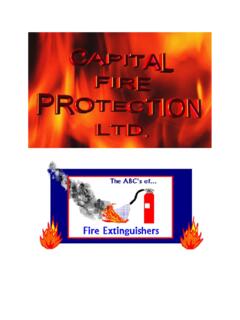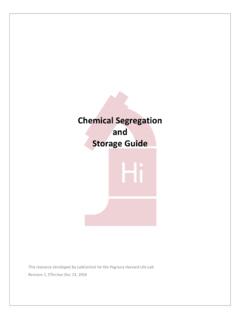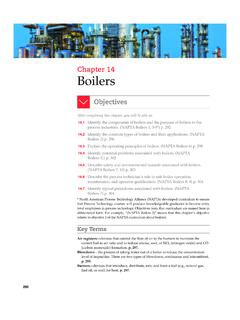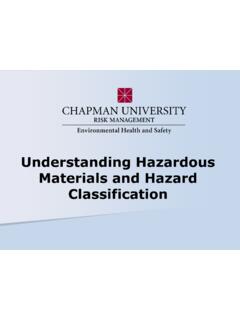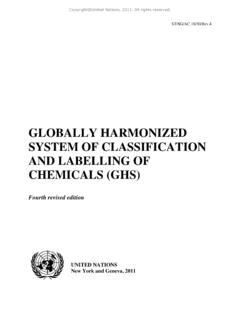Transcription of Handling and Storage of Flammable Materials at the Work ...
1 FEX002 Fire and Explosives 1 Revised May 2007 Handling and Storage of Flammable Materials at the Work Site What are Flammable Materials Flammable Materials are substances that can ignite easily and burn rapidly. They can be common Materials that are at most work sites in gas, liquid and solid forms. Some examples of Flammable Materials include: Gases Natural gas, propane, butane, methane, acetylene, carbon monoxide, hydrogen sulphide. Flammable gases are usually gases with a lower explosive limit of less than 13 percent in air, or have a Flammable range in air of at least 12 percent. For example, butane is a Flammable gas because its lower explosive limit in air is 20 percent. Carbon monoxide has a lower explosive limit of 13 percent and upper explosive limit of 74 percent in air, it is Flammable over a range of 61 percent. Liquids Gasoline, many solvents such as acetone, alcohols and toluene, paints and paint thinners, adhesives, degreasers, cleaners, waxes and polishes.
2 Flammable liquids have a flashpoint below (1000F). FEX002 Fire and Explosives 2 Revised May 2007 Solids Some types of coal, pyrophoric metals (metals that burn in contact with air or water, such as sodium and potassium) solid wastes that are soaked with Flammable liquids (rags, paper, spill clean up products), gunpowder, matches. How do fires occur For a fire to occur, there are three elements that must come together at the same time and in the right proportions, fuel, heat (ignition source) and oxygen. Remove any of the elements and the fire will go out. The fire triangle is commonly used as a model to understand how a fire starts and how it can be prevented. Figure 1 Fire Triangle Fuel Fuels are Flammable or combustible Materials and can be gases, liquids or solids. Heat These are ignition sources and include an open flame, lit cigarette and sparks (such as from electrical current and static electricity shorts).
3 A chemical reaction that creates heat can also ignite a fuel and oxygen mixture. Oxygen The most common source of oxygen is air, but oxygen can also come from chemicals called oxidizers. Examples of common oxidizers are some types of acids and chemicals such as chlorine, chlorine dioxide, potassium permanganate and potassium chlorate. FEX002 Fire and Explosives 3 Revised May 2007 The spread or propagation of fire is also dependant on a fourth factor, the chemical chain reactions that occur after the fire is started. Fire prevention consists of making sure that the three legs of the fire triangle never meet. It is important to note that a fire will not always start even when the legs of the triangle meet unless all three elements are present in right amounts. For example, vapours from a Flammable liquid must be mixed with a certain amount of air and exposed to the right amount of heat to ignite and burn.
4 Once vapours from a Flammable liquid have ignited, the flames may flash-back . This means the flames travel back, through the vapour-air mixture, to the container or source of the Flammable liquid . This can create an explosion. Most Flammable liquids produce vapours that are heavier than air. Some Flammable gases are also heavier than air. These gases and vapours can spread a considerable distance along the ground or floor and be ignited by a distant spark or flame or source of heat. Certain chemicals such as organic peroxides ( benzoyl peroxide) contain both fuel and oxygen. Special extra attention is needed for the safe Handling and Storage of these Materials . Other hazards from Flammable Materials In addition to the danger of fire, Flammable Materials may themselves present a health hazard. This can occur at air concentrations well below those needed to create a fire hazard. For example, the lower explosive limit for acetone is percent acetone in air (about 25,000 parts per million), however workers can experience health effects such as irritation and intoxication at concentrations of 1,000 parts per million.
5 Flammable gases such as carbon monoxide and hydrogen sulphide are toxic at very low concentrations. Most vapours from Flammable liquids are heavier than air and will accumulate near the ground. They can displace the air. When there is not enough air or oxygen, there is a hazard of asphyxiation (suffocation). FEX002 Fire and Explosives 4 Revised May 2007 When Flammable Materials burn, toxic gases and vapours are produced. Combustion products can include chemicals such as carbon monoxide, hydrogen cyanide and nitrogen oxides. If the substance burning contains chlorine, other irritating and toxic chemicals, such as acrolein and hydrogen chloride, can be produced. Common terms Autoignition temperature Lowest temperature at which a Flammable material will ignite on its own and burn without the introduction of a flame or spark (ignition source). Heating a Flammable material to its autoignition temperature in a normal atmosphere will cause it to ignite and burn (for example, splashing a Flammable liquid onto a hot surface such as an exhaust header can result n a fire).
6 BLEVE This is a type of pressure release explosion (boiling liquid expanding vapour explosion). It occurs when liquid containers fail (crack or rupture) due to fire. Combustible liquid A liquid with a flashpoint between 37OC (100OF) and 93OC (200OF). Kerosene and mineral spirits are examples of combustible liquids. Endothermic reaction A chemical reaction that absorbs heat. Exothermic reaction A chemical reaction that gives off heat. Explosion The very rapid build up and release of pressure resulting from the ignition of Flammable gases or Flammable liquid vapours in an enclosed container or space. Explosions usually occur in situations where fuel and air have been allowed to mix in the container or space before ignition so the combustion reaction occurs very quickly. The tendencies of the pre-mixed gases to expand on burning will cause a quick rise in pressure in the container which will result in damage to the container unless proper pressure venting occurs.
7 Flammable range The minimum and maximum concentration range of a Flammable vapour in air that can ignite on contact with an ignition source. FEX002 Fire and Explosives 5 Revised May 2007 Flashpoint The lowest temperature at which a Flammable or combustible liquid gives off enough vapour to form an ignitable mixture with air, since it is the vapour, not the liquid , which burns. The lower the value, the more easily the material will burn. Hot combustible liquids can generate as much Flammable vapour as cold Flammable liquids. Ignition point The minimum temperature at which a Flammable or combustible liquid gives off enough vapour to form a sustained ignitable mixture with air. Lower Explosive Limit (Lower Flammable Limit) Minimum concentration of a Flammable vapour in air that will burn. Below the LEL, the mixture is too lean to burn (too little fuel).
8 Oxidizer Oxygen or other substances capable of releasing oxygen. Generally, oxygen levels above 16 percent in air are needed to support combustion. In oxygen rich environments (above 21 percent), burning will be intensified. Pyrolysis Decomposition or transformation of a compound caused by heat. Upper Explosive Limit (Upper Flammability Limit) The maximum concentration of a Flammable vapour in air that will burn. Above the UEL, the mixture is too rich to burn (not enough oxygen). Vapour pressure A measure of a liquid s ability to evaporate. The higher the vapour pressure, the higher the evaporation rate resulting in more vapours being produced. Flammable liquids tend to have high vapour pressures. FEX002 Fire and Explosives 6 Revised May 2007 Work procedures and training The employer must develop work procedures for the use and Storage of Flammable Materials and ensure workers are trained on these procedures.
9 Because of the potential fire hazard, the employer will also need to have additional procedures in place to deal with fires and spills. Work procedures should address: Storage dispensing spill clean up incompatible Materials use and maintenance of engineering controls used in the workplace (such as ventilation) required personal protective equipment for Handling Flammable products fire protection and prevention special circumstances ( confined spaces, hot work) which may require additional precautions and training Good references that provide additional information that can be used for training are: Fire Facts: Flammable Liquids Fire Facts: Propane These documents are also available from the Alberta Municipal Affairs, Fire Commission s Office at (780) 427-8392 or by email at Alberta Fire Code: Part 4 ( Flammable and Combustible Liquids) and Part 5 (Hazardous Processes and Operations) provide some of the specific legal requirements for Storage , dispensing, use and Handling of Flammable liquids and gases in Alberta.
10 Canadian Natural Gas Code Canadian Propane Gas Code FEX002 Fire and Explosives 7 Revised May 2007 The above 3 documents are often available at your local fire department or in libraries. Further information on their content and on purchasing copies can be obtained from the Safety Services Branch of Alberta Municipal Affairs at 1-866-421-6929 or by email at The Alberta Fire Code can be purchased online from the Learning Resources Centre at or in CR-ROM form from the National Research Council Canada at Fire Protection, A Health and Safety Guideline for your Workplace available from the Ontario Accident Prevention Association online at Storage of Flammable Materials In general, Flammable Materials must not be stored near exits, electrical equipment or heating equipment. They should always be stored in a separate, well-ventilated Storage area, away from potential sources of ignition.









